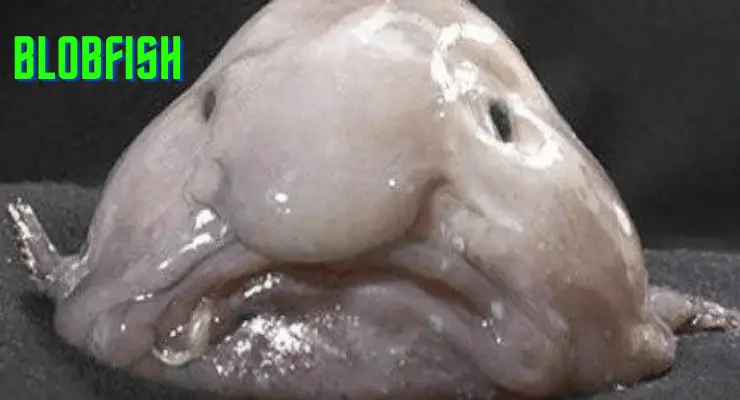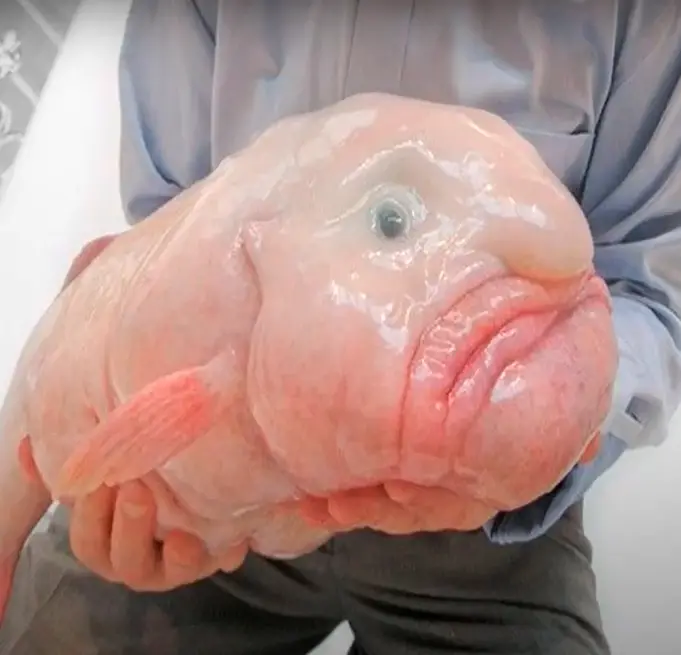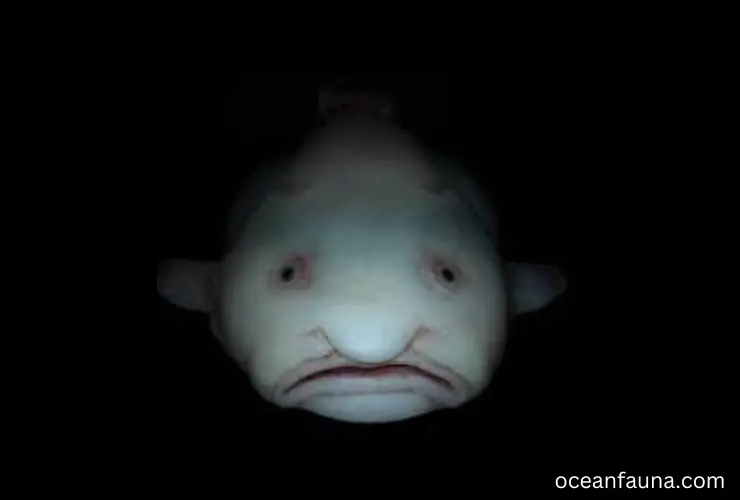In short, Yes. Blobfish is one of the endangered fish species since there are only 420 fish left worldwide. According to experts, this species can become extinct in the near future due to overfishing and destruction of their natural habitat.
In this article, I will discuss more detail on their conservation status and what actions are being taken to protect them.
Are Blobfish Endangered?
Yes, blobfish are an endangered species and will soon face a high risk of extinction.
The blobfish, also known as Psychrolutes marcidus, is a deep-sea fish that is typically found in waters around Australia, New Zealand, and Tasmania. This unusual-looking fish is known for its unique appearance, with a soft, gelatinous body and a distinct lack of muscles that give it a droopy, sad-looking appearance.
The blobfish is a relatively small fish, typically growing to around 30 cm in length, and it lives at depths ranging up to 2800 meters below sea level.

Conservation efforts are underway to protect the blobfish and prevent its extinction. These efforts include measures such as limiting fishing in known Blobfish habitat areas and supporting research into the species’ biology and behavior.
However, more must be done to protect this unique and fascinating species before it is too late. As experts in this area, it is essential to raise awareness about the plight of the blobfish and work towards creating a sustainable future for this endangered species.
How Many Blobfish Are Left Worldwide?
As per the latest surveys and research reports, there are only 420 blobfish left worldwide. This animal is critically endangered due to various factors such as overfishing, habitat destruction, and climate change. All these factors will be discussed later on.
Why Are Blobfish Endangered?
The blobfish, which is one of the most intriguing and unique-looking fish in the world, has been classified as an endangered species. This classification is the result of several factors that have led to a decline in the number of surviving blobfish. Here are some possible reasons explained below-
Overfishing
The blobfish is primarily found in the waters of Australia and Tasmania, where fishing occurs extensively. Unfortunately, the blobfish is not a targeted species but ends up as a bycatch in fishing nets.
As a result, their numbers have decreased considerably, and the situation worsens since they have a low reproductive rate and take a long time to reach maturity. Overfishing, combined with these factors, has resulted in a sharp decline in the blobfish population.
Habitat Destruction
Another significant factor contributing to the decline of the blobfish population is habitat destruction. The areas where they live, generally dark and deep waters, are increasingly being disturbed by human activities such as pollution, dredging, and offshore drilling.
These actions destroy the delicate oceanic environment the blobfish rely upon for survival.
Climate Change
Climate change has significantly impacted the oceans where the blobfish lives. Warming ocean temperatures are causing the ocean currents to shift, altering the habitats of the creatures that depend on them, including the blobfish. The changes in water temperature also affect the plankton, which is a crucial element in the blobfish diet.
Changes in water temperature, acidity levels, and ocean currents make it difficult for the blobfish to survive and reproduce.
Lack of Protection
Unfortunately, while some species of fish, such as whales and sea turtles, have numerous conservation policies in place, blobfish currently do not. Blobfish are not a big attraction for tourists or sports fishermen, so there is little incentive to maintain their population.
Thus, they have been neglected for long, remaining vulnerable and unprotected against overfishing and habitat destruction.
Others
The survival of blobfish may be affected by other threats like coral reef destruction, oil spills, and the introduction of invasive species.
What Conservation Efforts Are Taken?
In order to save the blobfish, numerous conservational efforts are being undertaken. Limiting fishing in known habitat areas is one of the most significant conservation measures taken to prevent species overexploitation. This approach has been implemented in many parts of the world where blobfish live to decrease their mortality rate.

Furthermore, supporting research into the blobfish’s biology and behavior is important to understand its ecology, habitat, and life cycle. This research is essential for the implementation of long-term protection plans and management strategies for the species.
Due to its deep-sea habitat, blobfish are not easily accessible. Thus, knowledge of the species is limited. To make up for this, scientists have conducted deep-sea research expeditions using remotely operated vehicles to observe the species in their natural habitat.
Another essential conservational effort is raising awareness about the blobfish’s plight. This is to inform the general public about blobfish’s challenges and encourage environmentally responsible behavior.
By increasing public awareness, people can take actions that will reduce the negative impact of their activities on the species’ habitat and population.
In addition, creating protected zones for blobfish habitats is also vital to ensure the species survival in the future. Establishing Marine Protected Areas (MPAs) is one way this can be achieved.
These MPAs aim to limit human activities such as fishing, oil exploration, and mining, which can negatively impact the habitat of the blobfish and other marine organisms.
For instance, the Great Barrier Reef in Australia has established MPAs to protect the blobfish and its habitat from environmental degradation and overexploitation.
Do Fishermen Catch Blobfish?
Fishermen do accidentally catch blobfish while engaging in their fishing activities. It is not a targeted catch, as blobfish are not a commonly sought-after species. However, due to their slow-moving nature, blobfish find it tough to evade large fishing nets and other equipment, making them vulnerable to being caught accidentally.
The accidental capture of blobfish can significantly threaten their already small population size. The species’ inherent vulnerability, coupled with accidental catches, can lead to overfishing, which can adversely impact their population.
Thus, it is crucial to exercise caution while fishing in areas where blobfish are known to reside so that their population can recover from any potential damages caused by human activities.
Are There Enough Food Sources for Blobfish?
Food sources for blobfish are scarce. Being adapted to living in an area of the ocean that lacks sufficient light, many other sea creatures cannot survive in the deep dark regions where blobfish dwell, which makes for a challenging environment for these creatures to hunt for food.
Blobfish rely on scavenging to survive and sustain themselves. They often prey on smaller fish, crabs, shrimp, and jellyfish that inhabit the depths of the ocean where they live. Yet, these sources of food are often not plentiful, creating a survival struggle for the blobfish.
Furthermore, scientists believe the blobfish, with their sluggish movements and minimal energy expenditure, are able to survive on minimal food sources. As the water pressure in their habitat is so immense, their organs and flesh become tightly compressed, allowing them to conserve energy.
Does IUCN Red-Listed the Blobfish?
The International Union for Conservation of Nature (IUCN) has not Red-Listed the blobfish. Despite being labelled as the “world’s ugliest fish,” the blobfish faces numerous threats, predominantly from human activities such as overfishing and deep-sea trawling.
Unfortunately, the blobfish has not yet been assessed for inclusion in the Red List of Threatened Species by the IUCN.
The Red List is a comprehensive tool used by conservationists to determine the conservation status of species throughout the world. The list is compiled by evaluating a variety of factors, including population size, distribution, and rate of decline.
It is categorized under nine different levels, ranging from Least Concern to Extinct, with various subdivisions in between.
Blobfish are primarily found in deep waters off the coast of Australia and New Zealand. Their long-term survival depends on the implementation of effective conservation measures. Without official recognition by the IUCN, mobilizing resources to conserve this species becomes difficult.
Highlight that the absence of a Red List status does not imply that blobfish are not in danger of extinction. Research suggests that heavy fishing pressure and entanglement in fishing nets are major threats the blobfish face.
The lack of assessment by the IUCN merely means that conservation efforts for blobfish are not receiving the attention and resources they require. Conservationists and policymakers must recognize the plight of blobfish and other lesser-known endangered species and work together toward their protection.
Are Blobfish Edible?
Yes, the blobfish are edible and can be consumed by humans without any adverse effects. However, blobfish must not be eaten raw as it might contain harmful toxins that can cause sickness or even death.
Cooking the blobfish is highly recommended to ensure the safety of the consumer. The rich and sweet taste of the blobfish is comparable to that of a butter-poached lobster tail and is considered a delicacy in some regions.
To prepare the blobfish for cooking, it should first be gutted and cleaned thoroughly. After this, it can be seasoned with salt and pepper and boiled, grilled, or fried. The flesh of the blobfish is tender, and the taste is enhanced when cooked with herbs and spices.
Remember, blobfish are endangered species whose population is rapidly decreasing due to overfishing. Therefore, ensure that the blobfish is obtained from legal and sustainable sources. Eating blobfish obtained by illegal means can result in significant legal consequences as well as ethical issues.
Conclusion
I hope you now understand that blobfish are in danger of extinction. Just because they do not have a Red List status does not mean they are not endangered. It is high time to take action and allocate resources to protect them for their long-term survival.
If you have further queries regarding blobfish, let me know. I will answer them.


2 thoughts on “Are Blobfish Endangered? [How Many Blobfish Left]”